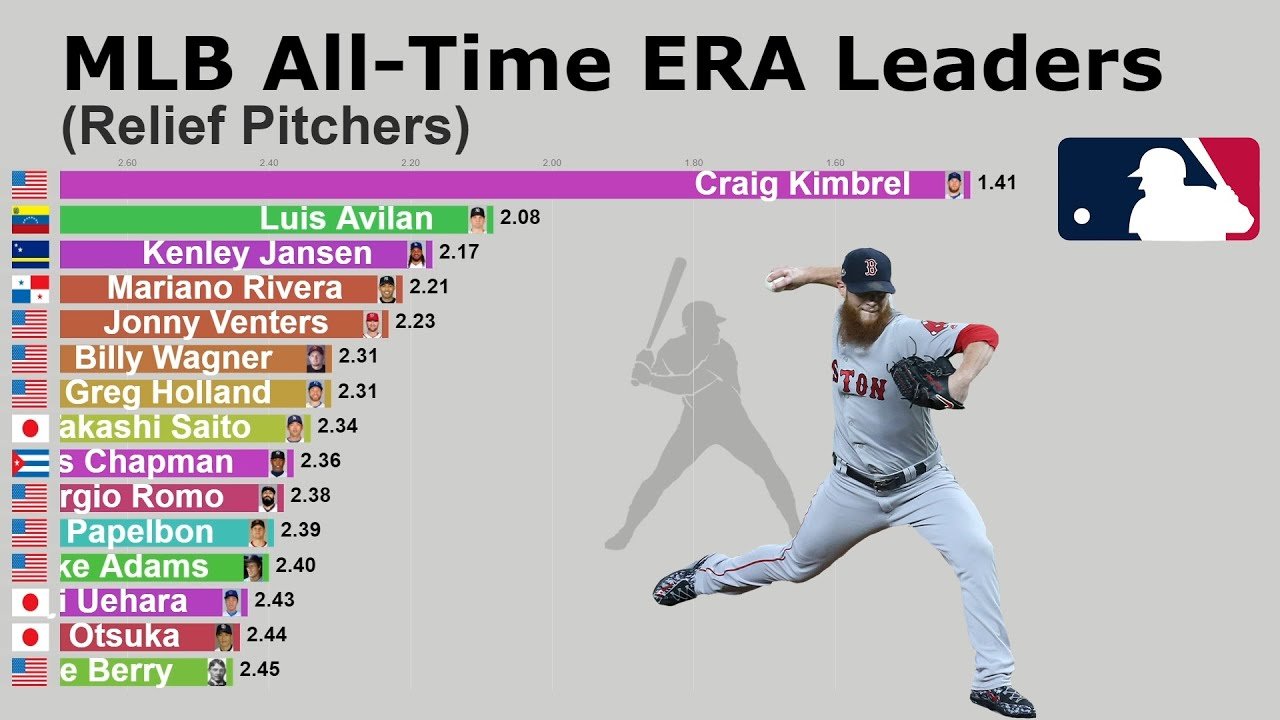ERA stands for Earned Run Average in baseball. It is a key statistic used to measure a pitcher’s effectiveness.
ERA represents the average number of earned runs a pitcher allows per nine innings. Understanding ERA is crucial for baseball fans and analysts. This statistic helps evaluate a pitcher’s performance without relying on team support. It focuses solely on the pitcher’s own skill.
Whether you’re new to baseball or a seasoned fan, knowing about ERA can deepen your appreciation of the game. This metric highlights the pitcher’s ability to prevent runs, making it essential for player comparisons and team strategies. In the following sections, we will explore how ERA is calculated, its significance, and its impact on the game of baseball. Let’s dive in and uncover the importance of ERA in baseball.
Defining Era
ERA stands for Earned Run Average. It is a key statistic in baseball. It measures a pitcher’s effectiveness. ERA calculates the average number of earned runs a pitcher allows per nine innings pitched. This statistic helps to evaluate a pitcher’s performance. Understanding ERA is important for fans and analysts.
Full Form Of Era
ERA stands for Earned Run Average. This statistic is crucial in baseball. It gives insight into a pitcher’s skill. A lower ERA means better performance. The term “earned run” refers to runs scored without errors. Unearned runs are not counted in ERA.
Basic Formula
The formula to calculate ERA is simple. Here it is:
ERA = (Earned Runs / Innings Pitched) 9Let’s break it down:
- Earned Runs: Runs scored without errors.
- Innings Pitched: Total innings a pitcher has thrown.
The result is then multiplied by 9. This gives the average number of earned runs allowed per nine innings. This standardizes the statistic, making it easier to compare pitchers.
Calculating Era
Calculating ERA is crucial for understanding a pitcher’s performance in baseball. ERA stands for Earned Run Average. It measures how many earned runs a pitcher allows per nine innings. Knowing how to calculate ERA helps fans and analysts evaluate pitchers effectively.
Steps To Calculate
- Determine the total earned runs allowed by the pitcher.
- Find the total innings pitched by the pitcher.
- Divide the earned runs by the innings pitched.
- Multiply the result by 9 to get the ERA.
Use the formula: ERA = (Earned Runs / Innings Pitched) 9
Example Calculation
Let’s say a pitcher has allowed 25 earned runs in 50 innings.
Follow these steps:
- Divide 25 by 50:
25 / 50 = 0.5 - Multiply by 9:
0.5 9 = 4.5
The pitcher’s ERA is 4.5.
| Earned Runs | Innings Pitched | ERA |
|---|---|---|
| 25 | 50 | 4.5 |
Significance Of Era
The Earned Run Average (ERA) is a crucial statistic in baseball. It measures a pitcher’s effectiveness. It gives insight into how many runs a pitcher allows per nine innings.
The lower the ERA, the better the pitcher’s performance. ERA helps fans, coaches, and analysts evaluate pitchers.
Evaluating Pitcher Performance
ERA is vital in evaluating pitcher performance. It shows how well a pitcher prevents runs. This statistic excludes errors and unearned runs, focusing only on a pitcher’s skill.
Consider a pitcher with an ERA of 2.50. This means they allow 2.5 earned runs per nine innings. This is considered excellent. A higher ERA, say 5.00, indicates more runs allowed, suggesting weaker performance.
Here are key points to remember:
- ERA below 3.00: Excellent performance
- ERA between 3.00 and 4.00: Good performance
- ERA above 4.00: Average to below-average performance
Comparing Pitchers
ERA also helps in comparing pitchers. It provides a standard measure across different games and seasons.
Imagine comparing two pitchers:
| Pitcher | ERA |
|---|---|
| Pitcher A | 3.20 |
| Pitcher B | 4.50 |
Pitcher A has a lower ERA, indicating better performance. This comparison helps teams make decisions on player selection. It also aids in contract negotiations and award considerations.
Here’s why ERA is useful:
- It’s a simple, easy-to-understand number.
- It’s widely recognized and respected.
- It’s effective for quick comparisons.
In summary, ERA is a powerful tool. It’s indispensable for evaluating and comparing pitchers.
Factors Influencing Era
Understanding ERA in baseball involves looking at various influencing factors. ERA, or Earned Run Average, measures a pitcher’s effectiveness. Two major factors impacting a pitcher’s ERA are the quality of defense and ballpark conditions. These factors can greatly affect a pitcher’s statistics.
Defense Quality
The quality of a team’s defense plays a crucial role in a pitcher’s ERA. A strong defense can prevent runs by making key plays. Good defensive players can catch difficult fly balls and stop ground balls. This reduces the number of earned runs. Conversely, a weak defense may lead to more errors. These errors often result in more runs scored against the pitcher. Thus, the pitcher’s ERA increases.
Ballpark Factors
Ballpark conditions also influence a pitcher’s ERA. Some ballparks are known to favor hitters. These parks have shorter outfield fences or higher altitudes. This makes it easier for batters to hit home runs. As a result, pitchers in these parks may have higher ERAs. On the other hand, some parks are pitcher-friendly. These parks have larger outfields and sea-level altitudes. This can help reduce the number of earned runs. Pitchers in these ballparks often have lower ERAs.
Limitations Of Era
ERA, or Earned Run Average, is a key baseball statistic. It measures a pitcher’s effectiveness. But, ERA has limitations. It doesn’t tell the whole story.
Context Dependency
ERA depends on the context of the game. Different ballparks have different conditions. Some parks favor hitters, others favor pitchers. ERA may not reflect these differences.
Also, the quality of the defense behind the pitcher matters. Strong defense can lower ERA. Poor defense can raise ERA. So, ERA can be misleading without this context.
Alternative Metrics
There are other metrics to consider. WHIP, or Walks plus Hits per Inning Pitched, is one. It measures base runners allowed per inning. This gives insight into a pitcher’s control and effectiveness.
FIP, or Fielding Independent Pitching, is another. It focuses on events a pitcher can control. Strikeouts, walks, hit by pitches, and home runs. FIP removes the influence of defense and ballpark factors.
Using these metrics alongside ERA gives a clearer picture. They help evaluate a pitcher’s true performance.

Credit: www.wikihow.com
Advanced Era Metrics
In baseball, the Earned Run Average (ERA) is a key metric for pitchers. But for a deeper understanding, we need to explore advanced ERA metrics. These metrics give a clearer picture of a pitcher’s performance, considering various factors beyond just earned runs.
Adjusted Era (era+)
ERA+ stands for Adjusted Earned Run Average. This metric adjusts a pitcher’s ERA according to the pitcher’s ballpark and the league average ERA. An ERA+ of 100 is league average. Higher numbers are better, indicating the pitcher is performing well above average.
For example, a pitcher with an ERA+ of 150 is 50% better than the league average. This metric helps compare pitchers from different teams and ballparks fairly.
Fielding Independent Pitching (fip)
FIP stands for Fielding Independent Pitching. This metric focuses on what a pitcher can control: strikeouts, walks, hit batters, and home runs. It removes the influence of fielding and luck from the equation. FIP is often seen as a better indicator of a pitcher’s true performance.
FIP is calculated using the following formula:
FIP = ((13HR) + (3(BB+HBP)) - (2K)) / IP + constant
In this formula:
- HR stands for Home Runs
- BB stands for Walks
- HBP stands for Hit By Pitch
- K stands for Strikeouts
- IP stands for Innings Pitched
The constant is set to align the scale of FIP with the league’s ERA.
Era In Modern Baseball
The Earned Run Average (ERA) is a critical statistic in baseball. It measures a pitcher’s performance. Specifically, it shows the number of earned runs a pitcher allows per nine innings. In modern baseball, ERA is essential for evaluating players.
Usage In Player Contracts
ERA plays a significant role in player contracts. Teams use ERA to assess a pitcher’s value. Lower ERAs often lead to higher salaries.
For instance, a pitcher with a 2.50 ERA is highly valued. Conversely, a pitcher with a 5.00 ERA may face challenges in contract negotiations.
Here is a simple comparison:
| ERA | Contract Value |
|---|---|
| 2.50 | $20 million/year |
| 5.00 | $5 million/year |
Teams consider ERA before offering long-term deals. A consistent ERA shows reliability and skill.
Role In Analytics
ERA is crucial in baseball analytics. Analysts use ERA to compare pitchers. It helps identify strengths and weaknesses.
Analytics teams create detailed reports. They use ERA to predict future performance. Here are some ways ERA is used:
- Trend Analysis: Track ERA changes over seasons.
- Performance Comparison: Compare pitchers with similar ERAs.
- Game Strategy: Use ERA to plan pitching rotations.
ERA is part of a larger analytical framework. It works with other metrics for a complete picture. Teams rely on ERA for strategic decisions.
In summary, ERA is vital in modern baseball. It impacts contracts and analytics. Its simplicity makes it a favorite among fans and experts.
Frequently Asked Questions
What Does Era Stand For In Baseball?
ERA stands for Earned Run Average. It’s a crucial pitching statistic. It measures the average number of earned runs a pitcher allows per nine innings.
How Is Era Calculated In Baseball?
ERA is calculated by dividing the total earned runs a pitcher allows by innings pitched, then multiplying by nine.
Why Is Era Important In Baseball?
ERA is important because it helps evaluate a pitcher’s effectiveness. It shows how well a pitcher prevents runs, a key aspect of the game.
What Is A Good Era In Baseball?
A good ERA in baseball is typically below 3. 00. This indicates the pitcher is highly effective at preventing runs.
Conclusion
Understanding ERA in baseball is crucial for fans and players alike. It measures a pitcher’s effectiveness. Lower ERA means better performance. This stat helps compare pitchers fairly. Knowing ERA can enhance your baseball experience. It adds depth to the game.
So, keep an eye on those ERA numbers. They tell a story. Happy baseball watching!





